Contemporary Issues in Criminology - Assignment
105 Pages41475 Words66 Views
Added on 2020-01-23
Contemporary Issues in Criminology - Assignment
Added on 2020-01-23
ShareRelated Documents
Contemporary issues in
Criminology: Use of
Surveillance in the Police
Criminology: Use of
Surveillance in the Police
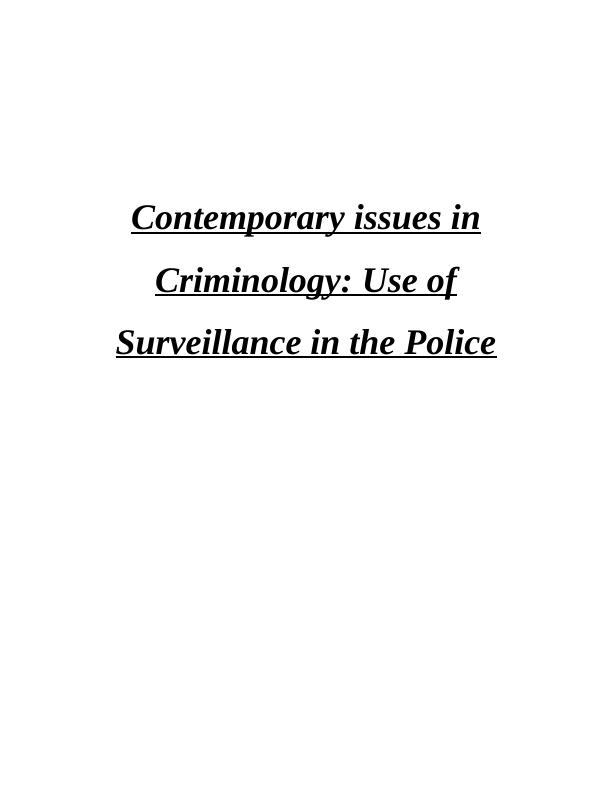
Table of Contents
CHAPTER 1 : INTRODUCTION...................................................................................................1
CHAPTER 2 : METHODS OF SURVEILLANCE .......................................................................2
CHAPTER 3 : POSITIVE ASPECTS OF SURVEILLANCE........................................................4
CHAPTER 4 : THEORIES OF SURVEILLANCE........................................................................6
CHAPTER 5 : CASES OF SURVEILLANCE...............................................................................8
CONCLUSION................................................................................................................................9
CHAPTER 7 : CAPITAL PUNISHMENT AND DIFFERENT THEORIES...............................14
CHAPTER 8 : ROLE OF JURY....................................................................................................24
CHAPTER 9 : CONTROL THEORY...........................................................................................26
CHAPTER 10 : COP CULTURE INFLUENCES POLICE BEHAVIOUR.................................28
CHAPTER 11 : DIFFERENT THEORIES...................................................................................34
CHAPTER 12 : VICTIMS OF CRIME.........................................................................................42
CHAPTER 13 : CRIMINAL JUSTICE.........................................................................................48
CHAPTER 14 : MEDIA AND CRIME .......................................................................................54
CHAPTER 15 : CESAR BECCARIA...........................................................................................57
CHAPTER 16 : POLICE CULTURE, DISCRETION AND ACCOUNTABILITY ARE
INCOMPATIBLE ELEMENTS OF THE CONCEPT OF POLICING’.......................................59
CHAPTER 17 : POLICING PROTESTS AND RIOTS................................................................64
CHAPTER 18 : CRIME AS A SOCIAL RATHER THAN INDIVIDUAL PHENOMENON.. .68
CHAPTER 19 : SOCIAL THEORY.............................................................................................73
CHAPTER 20 : YOUTH CRIME AND JUSTICE.......................................................................78
CHAPTER 21 : REFLECTIVE STATEMENT............................................................................83
REFERENCES..............................................................................................................................86
Appendix .......................................................................................................................................95
CHAPTER 1 : INTRODUCTION...................................................................................................1
CHAPTER 2 : METHODS OF SURVEILLANCE .......................................................................2
CHAPTER 3 : POSITIVE ASPECTS OF SURVEILLANCE........................................................4
CHAPTER 4 : THEORIES OF SURVEILLANCE........................................................................6
CHAPTER 5 : CASES OF SURVEILLANCE...............................................................................8
CONCLUSION................................................................................................................................9
CHAPTER 7 : CAPITAL PUNISHMENT AND DIFFERENT THEORIES...............................14
CHAPTER 8 : ROLE OF JURY....................................................................................................24
CHAPTER 9 : CONTROL THEORY...........................................................................................26
CHAPTER 10 : COP CULTURE INFLUENCES POLICE BEHAVIOUR.................................28
CHAPTER 11 : DIFFERENT THEORIES...................................................................................34
CHAPTER 12 : VICTIMS OF CRIME.........................................................................................42
CHAPTER 13 : CRIMINAL JUSTICE.........................................................................................48
CHAPTER 14 : MEDIA AND CRIME .......................................................................................54
CHAPTER 15 : CESAR BECCARIA...........................................................................................57
CHAPTER 16 : POLICE CULTURE, DISCRETION AND ACCOUNTABILITY ARE
INCOMPATIBLE ELEMENTS OF THE CONCEPT OF POLICING’.......................................59
CHAPTER 17 : POLICING PROTESTS AND RIOTS................................................................64
CHAPTER 18 : CRIME AS A SOCIAL RATHER THAN INDIVIDUAL PHENOMENON.. .68
CHAPTER 19 : SOCIAL THEORY.............................................................................................73
CHAPTER 20 : YOUTH CRIME AND JUSTICE.......................................................................78
CHAPTER 21 : REFLECTIVE STATEMENT............................................................................83
REFERENCES..............................................................................................................................86
Appendix .......................................................................................................................................95
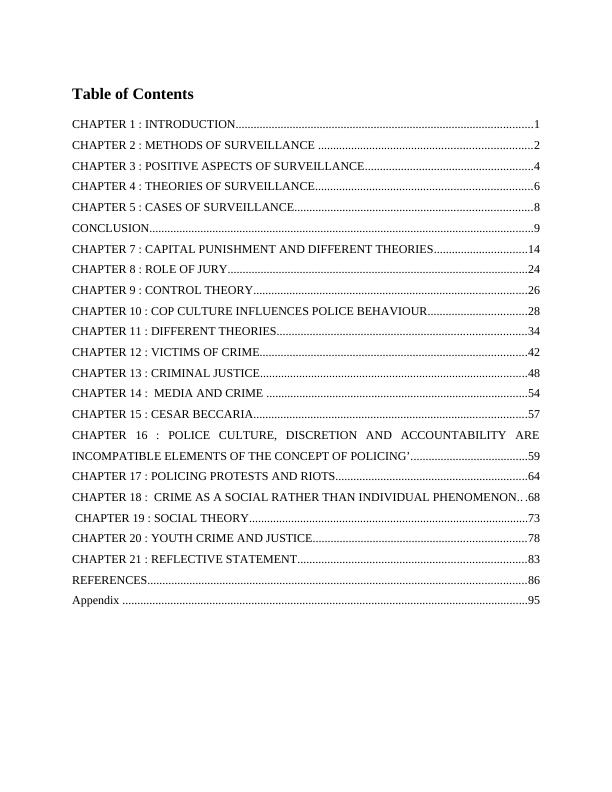
CHAPTER 1 : INTRODUCTION
The method used to monitor the activities, behaviour and other changing information of
people in order to manage, influence, direct or protect them is known as surveillance. It is used
by police for investigation of allegations of illegal behaviour by covert observation of people,
vehicles or places (1). It is one of the most vital and versatile skill that can be possessed by a
police officer. Surveillance has huge risks – it may result in death or injury when undercover
officers are unmasked of their identity and purpose. However, it is also essential for police
department to carry out criminal investigation through using surveillance method. It involves
observing individual, monitoring their cell phone location and vehicles as well in regard to know
their exact location. Thus, using such type of surveillance is crucial and thus it helps police in
identifying the location of criminal. The main objective of surveillance includes – obtaining
information, locating a subject and obtaining intelligence regarding that subject or location,
preventing occurrence of crime through covert or overt surveillance and providing protection to
undercover police officers (Larsen, Ellefsen and Sollund, 2012).
1
The method used to monitor the activities, behaviour and other changing information of
people in order to manage, influence, direct or protect them is known as surveillance. It is used
by police for investigation of allegations of illegal behaviour by covert observation of people,
vehicles or places (1). It is one of the most vital and versatile skill that can be possessed by a
police officer. Surveillance has huge risks – it may result in death or injury when undercover
officers are unmasked of their identity and purpose. However, it is also essential for police
department to carry out criminal investigation through using surveillance method. It involves
observing individual, monitoring their cell phone location and vehicles as well in regard to know
their exact location. Thus, using such type of surveillance is crucial and thus it helps police in
identifying the location of criminal. The main objective of surveillance includes – obtaining
information, locating a subject and obtaining intelligence regarding that subject or location,
preventing occurrence of crime through covert or overt surveillance and providing protection to
undercover police officers (Larsen, Ellefsen and Sollund, 2012).
1
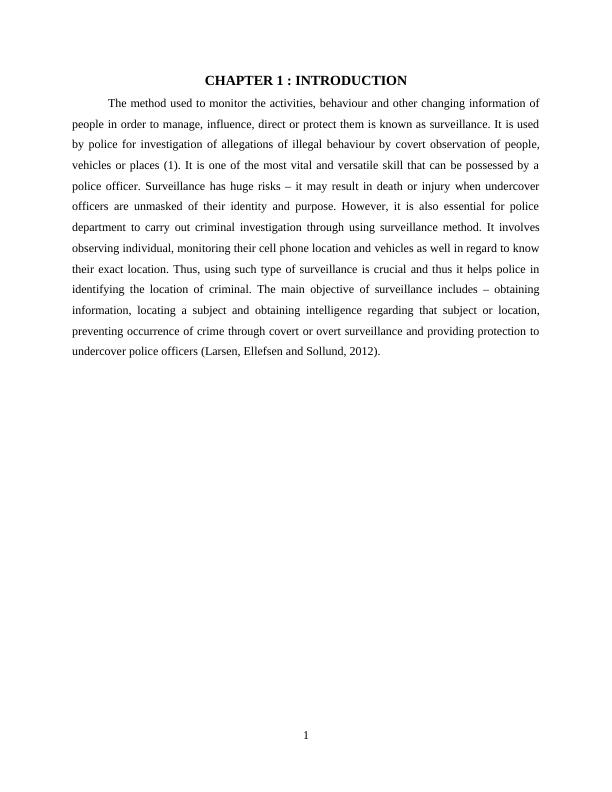
CHAPTER 2 : METHODS OF SURVEILLANCE
Surveillance is a complex process and a number of methods and techniques can be
adopted to ensure its effectiveness. The police uses a wide range of methods of surveillance that
are described as follows :
Electronic monitoring : It is also known as wire tapping, it refers to the surveillance of
fax, emails, telephone communication and internet. A court order is required to carry out
this surveillance whereby it is required to show that a crime has been or is being or will
be committed. After the court grants the order, criminal conspirators can be identified by
police agencies so that the involved offenders can be deterred or punished (2.pp.451-
469). But in certain cases, where there is risk of death or severe injury, the government
would be allowed to start monitoring without the order of a court.
Fixed surveillance : This is also referred to as stakeout in which police officers are
required to keep a surreptitious observation on people and place from a distance. This
method include two variations – one person surveillance in which officer cannot take his
eyes off the scene and do not get any relief and two person surveillance where officers
switch their positions periodically. This reduces the chances of spotting them by the
suspect.
Stationary technical surveillance : Hidden cameras and recording equipment are
installed by the investigators in a parked car. It is also known as unmanned surveillance
because there is no need for officers to monitor the suspect round the clock. Video
images and photos can be recorded anytime and it also reduces the risk of discovery.
Three person surveillance : This is a complex technique which reduces the possibility
of detection to a great extent (3). It is also called ABC method where officer A remains
behind the suspect, officer B follows him and officer C is on the other side of the street
who moves slightly ahead or behind the suspect.
Undercover operations : In this method, an active role is played by police officers to
reveal the criminal activities. For instance – an undercover officer may infiltrate with the
group by adopting similar jobs or hobbies of suspects. To gain trust and acceptance, he
might create a reasonable cover story that justifies his presence in the
neighbourhood/group.
2
Surveillance is a complex process and a number of methods and techniques can be
adopted to ensure its effectiveness. The police uses a wide range of methods of surveillance that
are described as follows :
Electronic monitoring : It is also known as wire tapping, it refers to the surveillance of
fax, emails, telephone communication and internet. A court order is required to carry out
this surveillance whereby it is required to show that a crime has been or is being or will
be committed. After the court grants the order, criminal conspirators can be identified by
police agencies so that the involved offenders can be deterred or punished (2.pp.451-
469). But in certain cases, where there is risk of death or severe injury, the government
would be allowed to start monitoring without the order of a court.
Fixed surveillance : This is also referred to as stakeout in which police officers are
required to keep a surreptitious observation on people and place from a distance. This
method include two variations – one person surveillance in which officer cannot take his
eyes off the scene and do not get any relief and two person surveillance where officers
switch their positions periodically. This reduces the chances of spotting them by the
suspect.
Stationary technical surveillance : Hidden cameras and recording equipment are
installed by the investigators in a parked car. It is also known as unmanned surveillance
because there is no need for officers to monitor the suspect round the clock. Video
images and photos can be recorded anytime and it also reduces the risk of discovery.
Three person surveillance : This is a complex technique which reduces the possibility
of detection to a great extent (3). It is also called ABC method where officer A remains
behind the suspect, officer B follows him and officer C is on the other side of the street
who moves slightly ahead or behind the suspect.
Undercover operations : In this method, an active role is played by police officers to
reveal the criminal activities. For instance – an undercover officer may infiltrate with the
group by adopting similar jobs or hobbies of suspects. To gain trust and acceptance, he
might create a reasonable cover story that justifies his presence in the
neighbourhood/group.
2
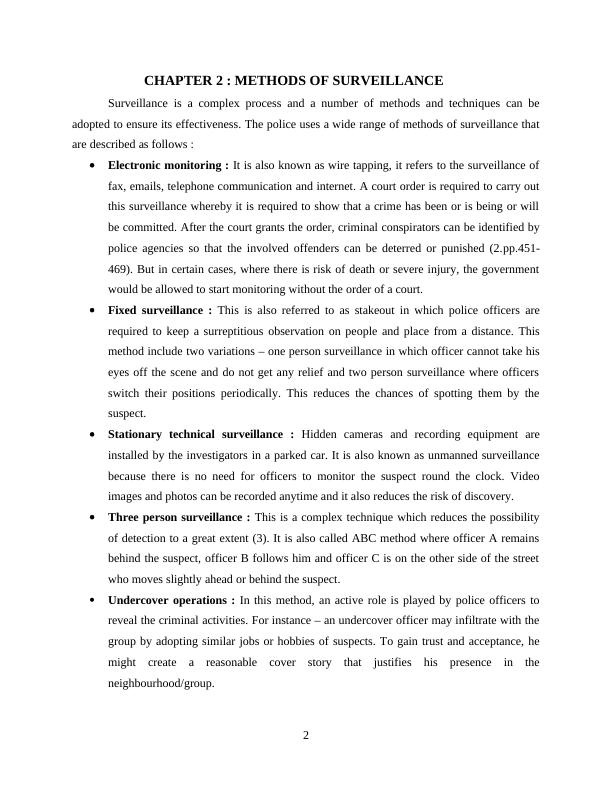
The surveillance methods enables the police to collect data and the content of communication i.e.
the type of device used and information transmitted with the use of different resources such as
bulk of data can be collected through the internet.
3
the type of device used and information transmitted with the use of different resources such as
bulk of data can be collected through the internet.
3

CHAPTER 3 : POSITIVE ASPECTS OF SURVEILLANCE
Positive scope of surveillance : Surveillance has proved to be quite beneficial for detection and
reduction of criminal activities. Through using body cams on police it helps in providing clear
picture why any police shoot the criminal. It is essential because incidents of polie shooting
black people without any reason are increasing and thus it helps in providing safety to such
people so that they are not able to affect them. It also helps in safeguarding innocent people and
thus police need to give clear justification that why they shot or murdered any person. Also,
recording through mobile phone is also the best surveillance way adopted by police. Michel
Foucault introduces the theory of freedom of people and in that he reviews that body cameras are
crucial in order to give proper judgement so that use of body cameras are effective. Some of the
positive aspects of surveillance are mentioned hereunder :
Complaints about behaviour of police officer and use of force is minimised due to the
record of every interaction with the residents as interactions captured can be seen by
everyone. It means that each and every conversation made with police needs to recorded
using body cameras or mobile phones.
Hard video evidences are provided by the use of cam when decisions are made by the
officers in highly intense situations on duty (4.pp.725-749).
Video recorded by body cams helps in protecting any kind of false accusations, abuse or
misconduct against officers.
It ensures increased accountability and transparency of the officers.
Confrontational situations between civilians and police officers may be prevented and de-
escalated.
It helps in providing valuable evidence to obtain victim statements and accurate
witnesses.
The court proceeding can be conducted speedily as it provides undisputable evidence of
situations by video footages captured. Therefore, it helps to reduce the expenses of the
court due to increase in pre – trial plea bargains or increased rate of convictions. It means
that lack of evidence affects the court time, money and other resources so that all these
could be saved.
4
Positive scope of surveillance : Surveillance has proved to be quite beneficial for detection and
reduction of criminal activities. Through using body cams on police it helps in providing clear
picture why any police shoot the criminal. It is essential because incidents of polie shooting
black people without any reason are increasing and thus it helps in providing safety to such
people so that they are not able to affect them. It also helps in safeguarding innocent people and
thus police need to give clear justification that why they shot or murdered any person. Also,
recording through mobile phone is also the best surveillance way adopted by police. Michel
Foucault introduces the theory of freedom of people and in that he reviews that body cameras are
crucial in order to give proper judgement so that use of body cameras are effective. Some of the
positive aspects of surveillance are mentioned hereunder :
Complaints about behaviour of police officer and use of force is minimised due to the
record of every interaction with the residents as interactions captured can be seen by
everyone. It means that each and every conversation made with police needs to recorded
using body cameras or mobile phones.
Hard video evidences are provided by the use of cam when decisions are made by the
officers in highly intense situations on duty (4.pp.725-749).
Video recorded by body cams helps in protecting any kind of false accusations, abuse or
misconduct against officers.
It ensures increased accountability and transparency of the officers.
Confrontational situations between civilians and police officers may be prevented and de-
escalated.
It helps in providing valuable evidence to obtain victim statements and accurate
witnesses.
The court proceeding can be conducted speedily as it provides undisputable evidence of
situations by video footages captured. Therefore, it helps to reduce the expenses of the
court due to increase in pre – trial plea bargains or increased rate of convictions. It means
that lack of evidence affects the court time, money and other resources so that all these
could be saved.
4
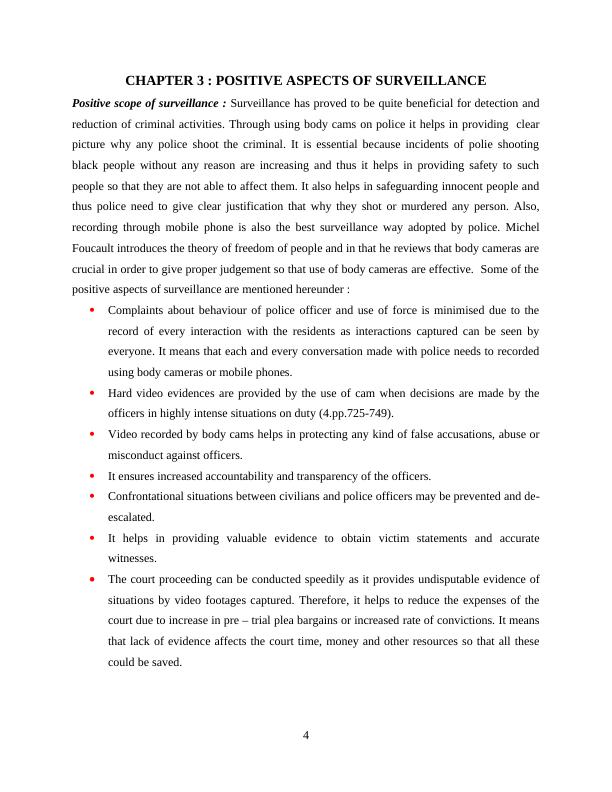
There are different cases which has been solved by surveillance cameras and thus it helps
police and court to be used as a main evidence. Therefore, use of CCTV footages also helps in
solving cases for police.
5
police and court to be used as a main evidence. Therefore, use of CCTV footages also helps in
solving cases for police.
5

CHAPTER 4 : THEORIES OF SURVEILLANCE
Marxist theory
According to this theory, crime and deviance are determined by ruling class and used as a
means of social control. It is argued that people who are involved in petty crimes on street such
as theft and burglary are treated as criminals and whole justice system focuses on their trial
rather than white collar crimes i.e. crimes committed by powerful segment of society is ignored.
There are numerous examples and cases in the real life world where it was seen that rich and
powerful people of the society committed serious offences and nothing happened to them, just
because they have power to influence police, politics and whole justice system which is based on
bureaucracy. On the other hand, poor people have to suffer a lot even if the crimes is not so
serious and they are blamed whole their lives.
Thus, in the context of surveillance, it becomes necessary to address that there need to be
made a balance between both positive and negative aspects of it. Police should not use its force
on poor and less powerful sections of the society. Moreover, the tool of surveillance should also
be used to identify and prevent crimes committed by rich people. Only when a proper balance is
maintained, the objectives of surveillance as a tool in justice and law can serve its purpose.
A study was conducted by Cambridge university with the regard to use of body cameras
by police officers (5). According to this study, there is a 50% reduction in use of force by police
officers and public complaints reduced by almost 90% when the police officers are equipped
with body camera. It found that both the public and police officer were adjusting their behaviour.
The social theory explains the bond between individual and society which is based on four major
elements – attachment, involvement, commitment and belief. In the context of using body
cameras by officers, it can be explained with reference to social theory as when the bond
between society and individual is strengthened, the chances of involvement in delinquency
reduces.
Michele foucault theory
In the context of body cameras, Michele foucalt theory provides an understanding of
disciplinary actions. In his opinion, modern society is a disciplinary society which means that in
today's time, power is mainly exercised through disciplinary means in different institution such
as prisons, schools etc.
6
Marxist theory
According to this theory, crime and deviance are determined by ruling class and used as a
means of social control. It is argued that people who are involved in petty crimes on street such
as theft and burglary are treated as criminals and whole justice system focuses on their trial
rather than white collar crimes i.e. crimes committed by powerful segment of society is ignored.
There are numerous examples and cases in the real life world where it was seen that rich and
powerful people of the society committed serious offences and nothing happened to them, just
because they have power to influence police, politics and whole justice system which is based on
bureaucracy. On the other hand, poor people have to suffer a lot even if the crimes is not so
serious and they are blamed whole their lives.
Thus, in the context of surveillance, it becomes necessary to address that there need to be
made a balance between both positive and negative aspects of it. Police should not use its force
on poor and less powerful sections of the society. Moreover, the tool of surveillance should also
be used to identify and prevent crimes committed by rich people. Only when a proper balance is
maintained, the objectives of surveillance as a tool in justice and law can serve its purpose.
A study was conducted by Cambridge university with the regard to use of body cameras
by police officers (5). According to this study, there is a 50% reduction in use of force by police
officers and public complaints reduced by almost 90% when the police officers are equipped
with body camera. It found that both the public and police officer were adjusting their behaviour.
The social theory explains the bond between individual and society which is based on four major
elements – attachment, involvement, commitment and belief. In the context of using body
cameras by officers, it can be explained with reference to social theory as when the bond
between society and individual is strengthened, the chances of involvement in delinquency
reduces.
Michele foucault theory
In the context of body cameras, Michele foucalt theory provides an understanding of
disciplinary actions. In his opinion, modern society is a disciplinary society which means that in
today's time, power is mainly exercised through disciplinary means in different institution such
as prisons, schools etc.
6
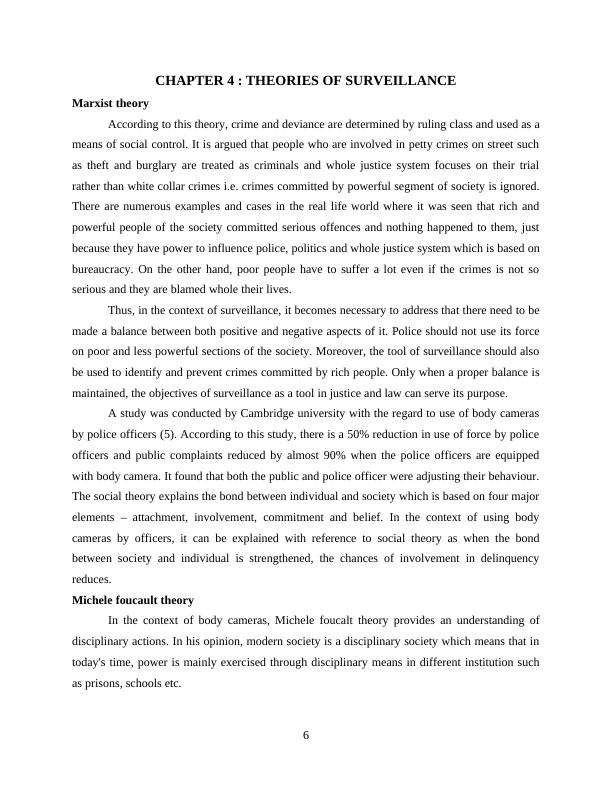
End of preview
Want to access all the pages? Upload your documents or become a member.
Related Documents
Principles and Application of Punishments in an Era of Mass Incarcerationlg...
|8
|2425
|268
Desklib Online Library for Study Materiallg...
|46
|12020
|279
